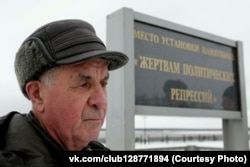Josef Stalin never visited the western Siberian city of Surgut. But earlier this month, local activists from the nationalist Russky Dukh (Russian Spirit) movement erected a bust of the Soviet dictator on the embankment of the Ob River.
"The idea came up when we were celebrating the 70th anniversary of victory [over Hitler's Germany in 1945]," Russky Dukh activist and Communist Party member Denis Khanzhin told RFE/RL. "To honor the leader of that victory: Generalissimus Josef Stalin."
The group collected 260,000 rubles ($4,000) for the project through online crowdfunding, said Khanzhin, 28. He claims that "60 percent" of locals back the idea of honoring Stalin.
A couple of hundred meters away from the bust, however, a wooden sign tells a different story: "On this spot we are building a monument to the victims of political repression."
Surgut, now the largest city in the natural-gas-rich Khanty-Mansiisk Autonomous District, was not formally part of Stalin's notorious gulag network. There were no camps there. But tens of thousands of dispossessed peasants from southern Russia, as well as thousands of representatives of deported ethnic groups such as Finns, Moldovans, and Volga Germans, were internally exiled there, euphemistically labelled "special resettlers."
Pavel Akimov, one of the organizers of the project to remember Stalin's victims, told RFE/RL what happened to him and his parents, independent farmers who were sent to Surgut from Tyumen Oblast in 1930.
"First they were sent to Tobolsk," says Akimov, 71. "Then to Khanty-Mansiisk, which was then called Ostyako-Vagulsk. From there, people were scattered around. My parents and others were simply dropped off on the banks of the river. They were given a few axes and shovels and told to dig themselves some bunkers. It was autumn. They were left to the whims of fate to survive."
'Special Resettlers'
Akimov's father died in 1950. His mother was only given an internal passport, which would have allowed her to leave the region, in 1964, but by then she and her three sons had nowhere to go. The family received an official certificate of "rehabilitation" -- meaning they were recognized as innocent victims of repression -- in 1991, the year the Soviet Union ceased to exist.
Like Akimov, many people in Surgut and the surrounding region today are the descendants of Stalin's "special resettlers." Akimov says there are still 760 children of the exiled in Surgut itself, and a total of about 10,000-15,000 descendants and their families in the surrounding region.
For more than a year, Akimov's group, Our Memory, has been raising funds to erect the monument and negotiating with local officials on the details of the project.
Khanzhin told RFE/RL that there is no reason for the descendants of the exiled to object to the Stalin monument. After all, he says, the dictator gave their relatives work when he evacuated a fish cannery to the city from Odesa, in Ukraine, during the war.
"They could work for the good of the motherland," Khanzhin said. "We shouldn't confuse these people with Gulag prisoners who were convicted under the law. And their descendants, I think, are not so bad off now. After all, their relatives were not shot, and they were able to work for the benefit of the motherland, to help during the war. And now they themselves live in a wonderful, rich city."
"What's more, that's 'how the steel was tempered,'" he added, meaning how people who endured such hardships were made tough. "Stalin himself went through this school -- he was exiled, but he dealt with it and became not a criminal but a statesman!"
He acknowledges that there are many opinions about Stalin, but says accounts putting the number of people Stalin killed in the tens of millions are "myths" from the perestroika era.
Drenched In Red
Not everyone seems to agree with his views. At least twice during the bust's first two weeks, unknown vandals drenched it in blood-red paint. Local officials say the Stalin bust was installed without permission and that it might be removed following an investigation by the municipal monuments committee.
Khanzhin denies that his group intentionally placed the Stalin bust next to the place where the victims' memorial is to be. He says Russky Dukh has no objection to the proposed memorial.
"People need to know history and the two [monuments] will complement one another," he said. Moreover, Stalin himself, Khanzhin claimed, "was a victim of [Soviet leader Nikita] Khrushchev's political repressions."
Akimov agrees that people need to know history -- but fears that young Russians of Khanzhin's generation know nothing of what happened to the Soviet people under Stalin.
"No one teaches them this and so no one knows," Akimov told RFE/RL. "In textbooks there is just the phrase 'there were repressions.' Two words -- that is all. And who remembers the summary executions of 1937 and 1938 when nearly 1 million people were shot -- just according to official figures."
"I have children, and they know that I was repressed. When I tell them about my parents, I get chills," he said. "When we were gathering information about the people who were shot here [in Surgut], I wrote it all down but for a long time I couldn't look at those papers. I began trembling when I saw those pages and how whole families were shot down. Not only healthy men who might do something illegal. But what about a 70-year-old? What was he shot for? But they stood him up against the wall together with small children. You don't have to experience that yourself -- just seeing such things on paper is horrifying."












